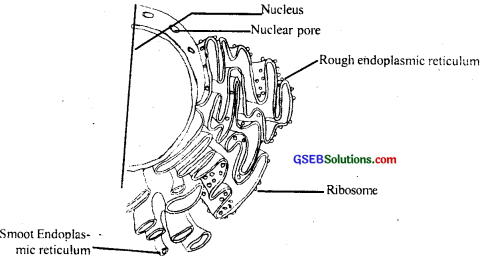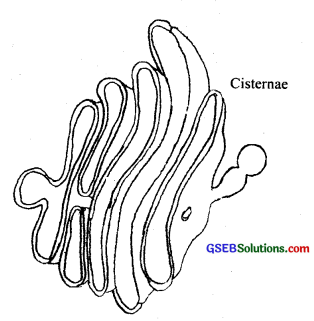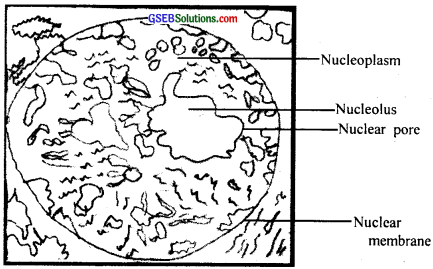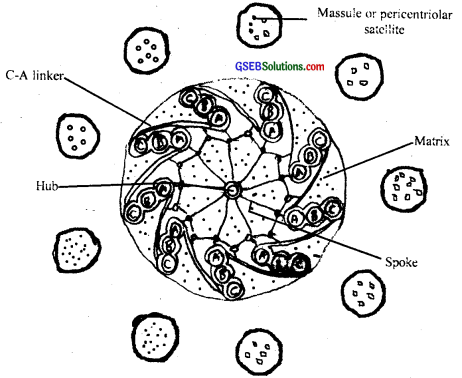Gujarat Board GSEB Textbook Solutions Class 11 Biology Chapter 8 Cell: The Unit of Life Textbook Questions and Answers.
Gujarat Board Textbook Solutions Class 11 Biology Chapter 8 Cell: The Unit of Life
GSEB Class 11 Biology Cell: The Unit of Life Text Book Questions and Answers
Question 1.
Which of the following is not correct?
- Robert Brown discovered the cell.
- Schleiden and Schwann formulated the cell theory.
- Virchow explained that cells are formed from pre-existing cells.
- A unicellular organism carries out its life activities within a single cell.
Answer:
1. Robert Brown discovered the cell.
![]()
Question 2.
New cells generate from
- bacterial fermentation
- regeneration of old cells
- pre-existing cells
- abiotic materials
Answer:
3. pre-existing cells
Question 3.
Match the following

Answer:
- (ii)
- (iii)
- (i)
Question 4.
Which of the following is correct:
- Cells of all living organisms have a nucleus.
- Both animal and plant cells have a well-defined cell wall.
- In prokaryotes, there are no membrane-bound organelles.
- Cells are formed de novo from abiotic materials.
Answer:
1. Cells of all living organisms have a nucleus.
![]()
Question 5.
What is a mesosome in a prokaryotic cell? Mention the functions that it performs.
Answer:
Mesosome in a prokaryotic cell is a special membranous structure which is formed by the extensions of the plasma membrane into the cell. They are essentially infolding of the cell membrane. Functions of mesosome are:-
- They help in cell wall formation, DNA replication, and distribution to daughter cells.
- They help in the respiration, secretion process, to increase the surface area of the plasma membrane and enzymatic content.
Question 6.
How do neutral solutes move across the plasma membrane? Can the polar molecules also move across it in the same way? If not, then how are these transported across the membrane?
Answer:
Neutral solutes move across the plasma membrane by the process of simple diffusion along the concentration gradient i.e. from higher concentration to lower concentration. The movement of water by diffusion is called osmosis.
Polar molecules cannot move across the membrane by diffusion. They require a carrier protein of the membrane to facilitate their transport. Few ions or molecules are transported across the membrane against their concentration gradient i.e. from lower to higher concentration which is energy (ATP) consuming and is called active transport.
![]()
Question 7.
Name two cell-organelles that are double membrane-bound. What are the characteristics of these two organelles? State their functions and draw labelled diagrams of both.
Answer:
- Endoplasmic reticulum (ER)
- Golgi Complex
1. Endoplasmic reticulum characteristics: Endoplasmic reticulum (ER) divides the intracellular space into two distinct compartments i.e. luminal (inside ER) and extraluminal (cytoplasm) compartments. The ER often shows ribosomes attached to their outer surface. The endoplasmic reticulum bearing ribosomes on their surface is called the rough endoplasmic reticulum (RER). In the absence of ribosomes, they appear smooth and are called the smooth endoplasmic reticulum (SER).
Function :
- They are extensive and continuous with the outer membrane of the nucleus.
- The smooth endoplasmic reticulum is the major site for synthesis of lipid.
- In animal cells, lipids-like steroidal hormones are synthesised in SER.

2. Golgi Complex Characteristics: Golgi bodies consist of many flat, disc-shaped sacs or cisternae of 0.5pm to 1.0pm diameter. These are stacked paraded to each other. A varied number of cisternae are present in a Golgi complex. The Golgi cisternae are concentrically arranged near the nucleus with distinct convex ‘cis’ or the forming face and concave ‘trans’ or the maturing face.
The cis and the trans faces of the organelle are entirely different but interconnected.
Functions: The Golgi apparatus principally performs the function of packaging materials, to be delivered either to the intracellular targets or secreted outside the cell. Materials to be packaged in the form of vesicles from the ER fuse with the cis face of the Golgi apparatus and move towards the maturing face. This explains, why the Golgi apparatus remains in close association with the endoplasmic reticulum. A number of proteins synthesised by ribosomes on the endoplasmic reticulum are modified in the cisternae of the Golgi apparatus before they are released from its trans face. Golgi apparatus is the important site of formation of glycoproteins and glycolipids.

Question 8.
What are the characteristics of prokaryotic cells?
Answer:
Characteristics of Prokaryotic cell
- Prokaryotic cells are smaller and multiply more rapidly than eukaryotic cells.
- They have a cell wall surrounding the cell membrane and the fluid matrix filling the cell is the cytoplasm. They don’t have a well-defined nucleus.
- Few prokaryotes like bacteria have additional small circular DNA called plasmids outside the genomic DNA. These plasmids confer unique phenotypic characters to such bacteria.
- The prokaryotic cell does not contain membrane-bound organelles found in eukaryotes except ribosomes.
- A specialized differentiated form of the cell membrane called mesosome is found in prokaryotes. These are membranous structures formed by the extensions of the plasma membrane into the cell.
- Most prokaryotic cells like bacterial cells have chemically complex cell envelopes consisting of tightly bound three layers viz. the outermost glycocalyx, the cell wall, and the plasma membrane.
- Ribosomes are made of two subunits 50s and 30s units which when present together form 70s prokaryotic ribosomes.
- Reserve material in prokaryotic cells is stored in the cytoplasm in the form of inclusion bodies which lie free in the cytoplasm.
![]()
Question 9.
Multicellular organisms have a division of labour. Explain.
Answer:
The presence of several types of organ systems in the body of multicellular organisms is a. unique example of division of labour. Most cells of multi-cellular organisms come from a single cell the zygote, which divides to form cells. Groups of these newly formed cells become differentiated of specialised to perform specific functions and a division of labour’ is established between these cells which co-exist in the body of the multicellular organism. Cells of common origin and performing a similar but specific function constitute a tissue (e.g. muscle). Several types of tissues join collectively to form an organ which carries out one or more specific function (e.g. digestive, excretory, reproductive systems).
Question 10.
The cell is the basic unit of life. Discuss in brief.
Answer:
Every cell in an organism carries out all the biological activities independently. It releases energy by the breaking of food molecules. With this energy cell synthesizes complex molecules. Cells also play a major role in heredity. In plants, cells carry out photosynthesis. Each cell reproduces itself and has its own life cycle. The cell also regulates and maintains its own activities. So cell is considered a basic unit of life.
![]()
Question 11.
What are nuclear pores? State their function.
Answer:
The nuclear envelope contains a large number of perforations called nuclear pores. In some cases, the pores occupy up to 10 percent of the area of the nuclear envelope. The two membranes become continuous at the margin of each pore. A nuclear pore has a complex structure. It may have a diaphragm septum or plug of electron-dense material (nucleoplasm). Some pores possess membranous annuli or pocket-shaped outgrowths called blends.
A pore along with additional structures is called a pore complex. The nuclear pores control the passage of substances to the inside or outside of the nucleus. The nuclear pores are the passages through which the movement of RNA and protein molecules takes place in both directions between the nucleus and the cytoplasm.
Question 12.
Both lysosomes and vacuoles are endomembrane structures, yet they differ in terms of their functions. Comment.
Answer:
Lysosomes are membrane-bound vesicular structures formed by the process of packaging in the Golgi apparatus. The isolated lysosomal vesicles have been found to be very rich in almost all types of hydrolytic enzymes like lipases, proteases, carbohydrates, etc. These enzymes are capable of digesting carbohydrates, proteins, lipids, and nucleic acids.
Vacuoles are membrane-bound spaces found in the cytoplasm. It contains water, sap, excretory product, and other unuseful products of cells. It is bound by a membrane called tonoplast which facilitates the transport of a number of ions and other materials against a concentration gradient into the vacuole.
![]()
Question 13.
Describe the structure of the following with the help of labelled diagrams.
- Nucleus
- Centrosome
Answer:
1. Nucleus: Nucleus as a cell organelle was first described by Robert Brown as early as 1831. Later the material of the nucleus stained by the basic dyes was given the name chromatin by Flemming.
The interphase nucleus has highly extended and elaborate nucleoprotein fibres called chromatin, nuclear matrix and one or more spherical bodies called nucleoli. Electron microscopy has revealed that the nuclear envelope, which consists of two membranes with a space between (10 to 50nm) called the perinuclear space, forms a barrier between the materials present inside the nucleus and that of the cytoplasm. The outer membrane usually remains the perinuclear space, forms a barrier between the materials present inside the nucleus and that of the cytoplasm.
The outer membrane usually remains continuous with the endoplasmic reticulum and also bears ribosomes on it. At a number of places, the nuclear envelope is interrupted by minute pores, which are formed by the fusion of its two membranes. These nuclear, pores are the passages through which the movement of RNA and protein molecules takes place in both directions between the nucleus and the cytoplasm. The nuclear matrix or the nucleoplasm contains nucleolus and chromatin.
The nucleoli are spherical structures present in the nucleoplasm. The content of the nucleolus is continuous with the rest of the nucleoplasm as it is not a membrane-bound structure. It is a site for active ribosomal RNA synthesis. Larger and more numerous nucleoli are present in cells actively carrying out protein synthesis.

2. Centrosome: Centrosome is an organelle usually containing two cylindrical structures called centrioles. They are surrounded by amorphous pericentriolar materials. Both the centrioles in a centrosome lie perpendicular to each other in which each has an organisation like the cartwheel. They are made up of nine evenly spaced peripheral fibrils of tubulin. Each of the peripheral fibrils is a triplet. The adjacent triplets are also linked.
The central part of the centriole is also proteinaceous and called a hub, which is connected with tubules of the peripheral triplets by radial spokes made of protein. The centrioles form the basal body of the cilia or flagella, and the spindle fibers that give rise to the spindle apparatus during cell division in animal cells.

![]()
Question 14.
What is centromere? How does the position of the centromere form the basis of the classification of chromosomes? Support your answer with a diagram showing the position of the centromere on different types of chromosomes.
Answer:
Every chromosome has a region of primary constriction which is called the centromere. On the sides of the centromere, disc-shaped structures called kinetochores are present. Based on the position of the centromere, the chromosomes can be classified into four types:
- Metacentric: This type of chromosome has a middle centromere forming two equal arms of the chromosome.
- Sub-Metacentric: This type has a centromere slightly away from the middle of the chromosome resulting into one shorter arm and one long arm.
- Acrocentric: In this chromosome, the centromere is situated close to its end forming one extremely short and one very long arm.
- Telocentric: This chromosome has a terminal centromere.

